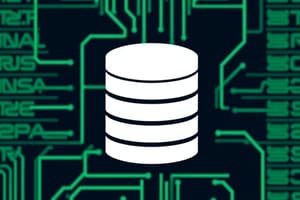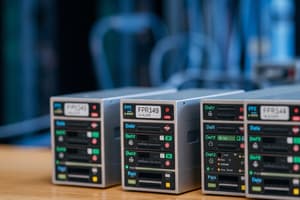Podcast
Questions and Answers
Which of the following best describes a business process?
Which of the following best describes a business process?
- A random series of events that occur within an organization.
- An unstructured approach to organizational management.
- A collection of independent tasks performed by individual employees.
- A structured set of activities designed to produce a specific output or service. (correct)
Business processes are always beneficial and can never be liabilities.
Business processes are always beneficial and can never be liabilities.
False (B)
Name a functional area commonly associated with specific business processes.
Name a functional area commonly associated with specific business processes.
Manufacturing and production, sales and marketing, finance and accounting, human resources
__________ is a functional area with business processes such as hiring employees and evaluating job performance.
__________ is a functional area with business processes such as hiring employees and evaluating job performance.
Match the functional area with the corresponding business process:
Match the functional area with the corresponding business process:
What is the primary focus of the field of Management Information Systems (MIS)?
What is the primary focus of the field of Management Information Systems (MIS)?
The field of MIS remains static, with little change in technology, management, and business processes over time.
The field of MIS remains static, with little change in technology, management, and business processes over time.
Which of the following is an example of IT innovation transforming the traditional business world?
Which of the following is an example of IT innovation transforming the traditional business world?
Which of the following is the primary benefit of using an Enterprise Resource Planning (ERP) system?
Which of the following is the primary benefit of using an Enterprise Resource Planning (ERP) system?
Which of the following accurately describes the primary role of a Database Management System (DBMS) within an organization?
Which of the following accurately describes the primary role of a Database Management System (DBMS) within an organization?
Transferring from a traditional file environment to a database environment is typically a short-term and inexpensive process for organizations.
Transferring from a traditional file environment to a database environment is typically a short-term and inexpensive process for organizations.
Organizations are typically less stable than informal groups due to their constantly changing routines and structures.
Organizations are typically less stable than informal groups due to their constantly changing routines and structures.
What is the primary advantage organizations gain by organizing data effectively, beyond merely storing it?
What is the primary advantage organizations gain by organizing data effectively, beyond merely storing it?
Name three major components of an information system.
Name three major components of an information system.
An organization's information system (IS) uses rules for secure operations in data processing, which includes priorities in dispensing software applications and security measures. These rules are known as ______.
An organization's information system (IS) uses rules for secure operations in data processing, which includes priorities in dispensing software applications and security measures. These rules are known as ______.
In a database environment, records can be accessed through sequential file organization, typically used for processing the same _________.
In a database environment, records can be accessed through sequential file organization, typically used for processing the same _________.
Which of the following best describes the role of 'data' within an information system?
Which of the following best describes the role of 'data' within an information system?
How does the Direct File Access Method determine the location of a record within a database?
How does the Direct File Access Method determine the location of a record within a database?
An international firm is considering an Enterprise Resource Planning system. Which of the following factors would make ERP adoption the most suitable choice?
An international firm is considering an Enterprise Resource Planning system. Which of the following factors would make ERP adoption the most suitable choice?
What is the initial step modern companies should take to coordinate the many aspects of business that require information from various resources?
What is the initial step modern companies should take to coordinate the many aspects of business that require information from various resources?
Diversity in hardware and software poses no significant challenges when trying to integrate information across different departments in a modern company.
Diversity in hardware and software poses no significant challenges when trying to integrate information across different departments in a modern company.
Match each information system component with its description:
Match each information system component with its description:
Match the file organization method with its correct description.
Match the file organization method with its correct description.
A company struggles with incompatible data formats across its various departments. What solution will address this issue?
A company struggles with incompatible data formats across its various departments. What solution will address this issue?
How has e-commerce primarily impacted traditional marketing and advertising?
How has e-commerce primarily impacted traditional marketing and advertising?
Contemporary business firms in the 21st century are placing greater emphasis on hierarchical structures compared to employee empowerment.
Contemporary business firms in the 21st century are placing greater emphasis on hierarchical structures compared to employee empowerment.
What is the crucial role of IT in modern business plans?
What is the crucial role of IT in modern business plans?
Areas of an organization most affected by leveraging technology include producing the product, getting it to the stores, and making the customer ________.
Areas of an organization most affected by leveraging technology include producing the product, getting it to the stores, and making the customer ________.
Match the IT concepts with their correct descriptions:
Match the IT concepts with their correct descriptions:
Which of the following is a key challenge in using Information Systems (IS) for competitive advantage?
Which of the following is a key challenge in using Information Systems (IS) for competitive advantage?
The organizational structure and distribution of IS specialists are static and do not need to adapt to changing business strategies.
The organizational structure and distribution of IS specialists are static and do not need to adapt to changing business strategies.
According to the content, on whom does the responsibility for successfully developing and using an integrated IS usually fall?
According to the content, on whom does the responsibility for successfully developing and using an integrated IS usually fall?
Flashcards
DBMS
DBMS
Software that allows an organization to efficiently collect and manage data, acting as an interface between data resources and application programs.
Sequential File Organization
Sequential File Organization
A file organization method typically used for processing the same information in a specific order.
Direct/Random File Organization
Direct/Random File Organization
A file organization method used with magnetic disks, allowing direct access to records.
Index Sequential Access Method
Index Sequential Access Method
Signup and view all the flashcards
Direct File Access Method
Direct File Access Method
Signup and view all the flashcards
Integrating Data
Integrating Data
Signup and view all the flashcards
Competitive Advantage
Competitive Advantage
Signup and view all the flashcards
Organizing Data
Organizing Data
Signup and view all the flashcards
Business Process
Business Process
Signup and view all the flashcards
Business Process Liabilities
Business Process Liabilities
Signup and view all the flashcards
Functional Area Examples
Functional Area Examples
Signup and view all the flashcards
Management Information system (MIS)
Management Information system (MIS)
Signup and view all the flashcards
MIS Excitement
MIS Excitement
Signup and view all the flashcards
IT Innovation Examples
IT Innovation Examples
Signup and view all the flashcards
Online Streaming Services
Online Streaming Services
Signup and view all the flashcards
New world of doing business
New world of doing business
Signup and view all the flashcards
ERP (Enterprise Resource Planning)
ERP (Enterprise Resource Planning)
Signup and view all the flashcards
Data (in Information Systems)
Data (in Information Systems)
Signup and view all the flashcards
Hardware (in Information Systems)
Hardware (in Information Systems)
Signup and view all the flashcards
Software (in Information Systems)
Software (in Information Systems)
Signup and view all the flashcards
Telecommunications (in IS)
Telecommunications (in IS)
Signup and view all the flashcards
People (in Information Systems)
People (in Information Systems)
Signup and view all the flashcards
Procedures (in Information Systems)
Procedures (in Information Systems)
Signup and view all the flashcards
Organization (in IS)
Organization (in IS)
Signup and view all the flashcards
E-commerce
E-commerce
Signup and view all the flashcards
Mobile Management
Mobile Management
Signup and view all the flashcards
Modern Business Structure
Modern Business Structure
Signup and view all the flashcards
Information Technology (IT)
Information Technology (IT)
Signup and view all the flashcards
IS Organizational Structure
IS Organizational Structure
Signup and view all the flashcards
Business Strategy
Business Strategy
Signup and view all the flashcards
Leveraging Technology in the Value Chain
Leveraging Technology in the Value Chain
Signup and view all the flashcards
IS for Competitive Advantage
IS for Competitive Advantage
Signup and view all the flashcards
Study Notes
- Every organization faces different data resource management challenges.
- Effective information usage depends on proper data storage, organization, and delivery.
- The ability to manage data as an important resource relies on computer hardware and software capabilities.
Database Management System (DBMS)
- Software that efficiently collects and manages data within an organization.
- Serves as an interface between data resources and application programs.
- Transferring to a database environment from a traditional file one requires understanding of managerial, organizational and technological requirements.
Organizing Data
- Organizing data can be difficult but necessary for providing accurate information.
- Organizations gain a competitive edge using useful, well-organized data.
Accessing Records
- There are two types of accessible files for accessing database records:
- Sequential File Organization: Typically used for processing the same information.
- Direct/Random File Organization: Used with magnetic disks.
- Index Sequential Access Method:
- Records are stored in a file using the primary key.
- An index value is generated for each primary key and mapped with the record.
- Direct File Access Method: Uses a primary key with mathematical calculations to determine a record's location.
Integration of Information
- Coordination requires a variety of information from many resources.
- Data integration is the first step, especially in companies that use teams.
- Diversity in hardware and software creates difficulties when integrating information.
- Many software packages each use unique formats to store data files, exacerbating the problem.
- To integrate different types of information, find software that can either read different file types or use a common format.
Role of Enterprise Resource Planning
- Enterprise Resource Planning (ERP) integrates business processes like manufacturing, finance, sales, marketing, and HR into a single software system.
- The field is dominated by large and expensive software packages from companies such as SAP, Peoplesoft, and Oracle.
- ERP handles all financial accounting systems.
- ERP emphasizes purchasing, human resource management, and investment management.
- The system uses databases, processes, and rules to provide up-to-the-minute data on major financial issues.
- The primary strength is handling data for large companies operating in an international environment.
Information Systems, Organizations, and Business Processes
- An organization is defined as a stable, formal social structure that takes resources from the environment and processes them to produce outputs.
- Organizations are more stable than an informal group in terms of longevity and routines.
- Information systems (IS) consist of data, hardware, software, telecommunications, people, and procedures.
- Data is the input that the system uses to produce information.
- Hardware refers to the computer and its peripherals.
- Software consists of instructions that tell the computer how to take data in, how to process, how to display information, and how to store data and information.
- Telecommunications includes the hardware and software that enable fast transmission.
- People include the information systems professionals and users who design, construct, operate, and maintain systems.
- Procedures are rules for achieving ideal and secure operations in data processing, including prioritizing software application dispensation and security measures.
Business Process
- Refers to how work is organized, coordinated, and focused on producing a valuable product or service.
- Inefficient processes can be liabilities that impede organizational responsiveness and efficiency.
- Many business processes cross functional areas and require coordination across departments.
- Many business processes are tied to a specific functional area, for example:
- Manufacturing and production: Assembling the product, checking for quality, and producing bills of materials.
- Sales and marketing: Identifying customers, making them aware of the product, and selling it to them.
- Finance and accounting: Paying creditors, creating financial statements, and managing cash accounts.
- Human resources: Hiring employees, evaluating performance, and enrolling employees in benefits plans.
Management Information Systems (MIS)
- Aims to achieve broad information systems literacy, addressing behavioral and technical issues related to the development, use, and impact of IS.
- MIS is exciting due to continuous changes in technology, management, and business processes.
- IT innovation transforms the business world with cloud computing, mobile digital platforms, Big Data, business analytics, and social networks.
- New business models have emerged, such as online video streaming services like Netflix, Apple TV, and Amazon Prime Video.
- E-commerce is expanding and reinventing itself, disrupting traditional marketing and media firms.
- Management changes occur as increased availability and use of smartphones and tablets allow managers to be more in touch with remote employees.
- Firms and organizations are putting less emphasis on hierarchy and structure and more on employees in the 21st-century.
Information Technology in Organization
- Information Technology (IT) has become a vital part of every business, ranging from multi-national corporations to small businesses.
- The organizational structure of the IS function and the distribution of IS specialists are designed to meet the business's evolving strategies.
Information System and Strategy
- Strategy is described as the determination of the basic long-term goals and objectives of an enterprise and the adoption of courses of action and allocation of resources necessary for achieving these goals.
Information Systems and Business Strategy
- Leveraging technology in the value chain affects producing the product, getting it to the stores, and making the customer happy.
- Other examples are information system products and services.
Use of Systems for Competitive Advantage
- Using IS to beat the competition and increase the value of a product requires changing long standing processes and may fall on managers throughout the organization.
Studying That Suits You
Use AI to generate personalized quizzes and flashcards to suit your learning preferences.




